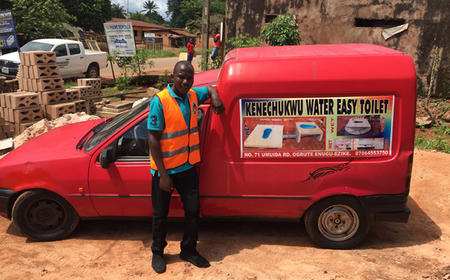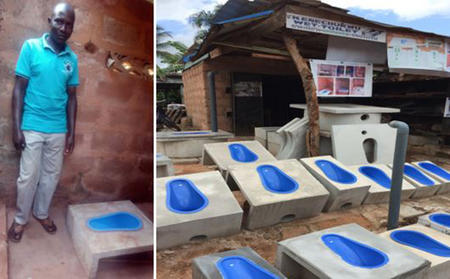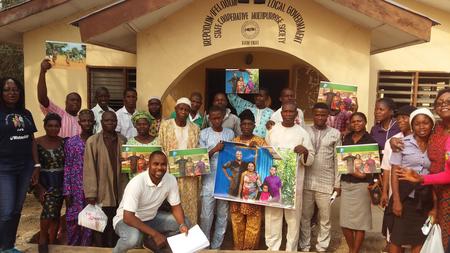Marketing and pride to improve sanitation in Nigeria

What is it that motivates people most to improve their toilets and hygiene behaviours? Nneka Akwunwa, Sanitation Marketing Manager at WaterAid Nigeria, tells us what she’s learned about using creative marketing.
Pride is stronger than disgust
In 2011, WaterAid ran a study of community-led total sanitation (CLTS), which revealed that disgust – a common CLTS motive – was not motivating latrine construction in Nigeria, and that pride was a much stronger motivator.
To explore this further, we designed the Sustainable Sanitation Project to look at both CLTS and sanitation marketing (specifically in Enugu and Ekiti states) to address the country’s sanitation crisis. We worked with creative agency 17 Triggers to develop innovative, pride-based promotional materials (shown in the image above) to help encourage people to buy sanitation products and adopt crucial sanitation and hygiene behaviours.
Nneka, how would you describe the sanitation situation in the Nigerian regions where WaterAid works?
I would use the word ‘crisis’. We have many beliefs that are hampering progress. Some people who can afford improved latrines will not purchase one because they do not see any immediate benefit in investing in toilets. Some people acquire toilets and don’t use them as they tend to ‘enjoy’ defecating in the open due to their belief in certain myths, and some because traditionally that’s what works for them. In some places we find people building new houses – big houses – without toilets.
The biggest challenge we have is that everybody expects to be given free toilets and hygiene materials. I think gradually people are beginning to understand our intentions, especially when you show them that the entrepreneurial development is creating jobs for people.
What prompted the move into SanMark (sanitation marketing) in WaterAid Nigeria?
We were not reaching as many people as we wanted to. There was a clear need for an alternative approach – using SanMark to complement CLTS to help scale up what it was achieving.
How are SanMark and CLTS linked?
What we are doing in SanMark is actually benefitting from what has been done in CLTS. If you look at SanMark sales trends you see that people are improving their existing latrines, converting them from the basic ones built during CLTS to the improved Water Easy Toilet (WET) model.
If we continue to implement CLTS we must let people know all the latrine options available so we don’t end up sending two different messages. We can take on both approaches and let people climb the sanitation ladder in a way that works for them. Willingness, affordability and aspiration drive demand structure, so let the market decide.
How did you find working with the creative agency?
The focus was to upscale marketing using 'below the line' techniques – methods targeted at specific groups, using, for example, leaflets, flyers or demonstrations. 17 Triggers were experienced in this, and I learned a lot from working with them, such as how to do direct sales.
I remember specifically when they presented me with a 'fake shit'. I never saw anything like that. We used it for our photo shoot of someone defecating in the open, which would have been difficult without it. We also use a prop that looks like a pile of faeces – it sure helps. The community members reacted quickly when we showed it to them: "Ah! What is she holding?!" "Don’t worry it is plastic." It looks very real and creates the effect that is required when talking about the risks of open defecation.
How did you develop and test the marketing materials?
We went to the field to test some initial messages, ask about language and show images to the community. A couple of the images they did not like – they were considered ‘disrespectful’ and they wanted images that showed respect and dignity. We dropped those and developed a new set, based on their feedback.
In our first meeting with 17 Triggers they asked us to describe rural Nigerian traditions and contexts – for example, our view of a good family, a good household, and the roles of men and women in the household.
I then went with a photographer, his crew and some models to one of our implementation states and took on-site pictures. We went through the processes of installing a latrine so that we could take active photos.
We went back to the community to show the pictures again to get their feedback. They were very excited about the new photos and happy to help eliminate open defecation in Nigeria.
The new set of promotional materials is more professional, and accessible and simple to use, developed so the sales agents can learn and guide their colleagues in how to use them. They are two-sided – on the side facing you are all the steps in what to say and do; the image is on the other side, visible to your potential customer. We are using these materials now to train facilitators who will, in turn, train the door-to-door agents.
What are people's initial reactions to the materials?
100% excitement. The materials are in use for sales and marketing events, and they are producing the expected results. We have used them to train the facilitators and the marketers. Customers can easily relate to the faces in the pictures and they love the promo materials.
How does gender affect decision-making about the toilets?
It is women who go to social gatherings discussing it with fellow women, and go back to their homes talking about it. Women will advocate for change as they feel they are the ones who have to face the difficulties of not having a toilet or good sanitation practice.
Most of the time, the women choose the design, style and type of toilet but would ask the husband to pay.
For a Nigerian man, being a man means providing for your household and safeguarding them. So most decisions are from the men, except where there is a female-headed household. This is why we looked at the message for men of 'protect your wife, protect your children, be a man'.
There is a common belief that women should not be the head of the household. We still have to work around this gender equality for decision-making around sanitation, hygiene products and services choice, and let everyone know that everyone has rights.
What do you see as the biggest challenge to SanMark?
The biggest challenge for me is to help all staff (within WaterAid and partners) and facilitators to understand SanMark in-depth. SanMark is new in Nigeria; we don’t have many people that understand it. It is difficult to find consultants to help – many have issues adapting their knowledge and skills to fit the sanitation businesses.
Many development practitioners find it hard to connect 'classic/traditional development' and market-based approaches. We say it is possible to do development that is market-based!
Beyond the toilet product itself, one key crucial element to make a successful SanMark business is to identify the right business. You need a business owner who is motivated, sees the opportunity the approach provides and is willing to give it his or her best to ensure it works.
How did you translate what you learned in Cambodia to Nigeria?
It is very different! Cambodia started with a product that was everywhere in the market – ceramic pour-flush; In Nigeria, we are working with a new product – the SaTo Pan in a concrete base.
The hands-off approach was a key lesson I took away. It is important to give businesses freedom to innovate; we follow up to ensure standards are kept. We learned our product was too big and heavy, so we have reduced it, but are still working on further reducing the size and weight without compromising safety. A couple of our innovative suppliers have come up with adapted models.
Another lesson was using marketing materials in sales events at village markets. The promotional materials have been a great sales tool, and our adaptation of a marketplace event I saw in Cambodia is already showing the potential to increase sales.






